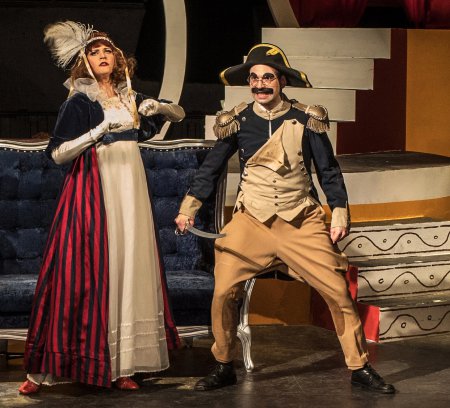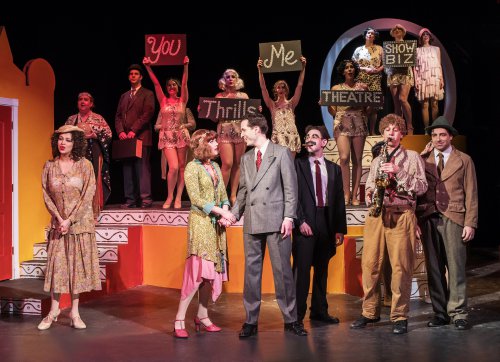I’ll Say She Is
Reconstructed version of lost 1924 Marx Brothers musical which helped create their personas seems to have dated over the years.

Melody Jane as Beauty and Noah Diamond as Groucho Marx in a scene from “I’ll Say She Is” (Photo credit: Stefan Timphus)
[avatar user=”Victor Gluck” size=”96″ align=”left” ] Victor Gluck, Editor-in-Chief[/avatar]The Marx Brothers’ first Broadway show, the 1924 I’ll Say She Is, was actually their longest running stage hit. However, unlike their next two shows written by George S. Kaufman, The Cocoanuts and Animal Crackers, this almost plotless musical revue was never filmed and was presumably forgotten and lost. Groucho Marx aficionado Noah Diamond has spent seven years attempting to reconstruct the 90-year-old show from the little that remains and is credited with “adaptation” and “expansion.” Seen in 2014 at the New York International Fringe Festival, I’ll Say She Is has returned for an Off Broadway run in yet another revised version.
Only a 30 page treatment and five songs remained from the original show by the Johnstone brothers, writer Will B. and composer Tom. Diamond has written new lyrics for music by Tom Johnstone and his brother Alexander as well as using songs from other shows written by Tom and Will. He has rearranged the plot, left out some sequences, and reduced the number of characters. The show at the Connelly Theater is not so much a revival as an homage to Marx Brothers musicals.
Unfortunately, this vaudeville-style show seems terribly dated. As directed by Amanda Sisk, the pace isn’t fast enough so that the material isn’t as funny as a Marx Brothers movie. The one liners like “Two decks of cards and not a brain cell between them,” “As far as I’m concerned the whole thing sphinx,” “I’m off to make Russia safe for French pastry,” and “I shall not fire until I see the whites of their eggs” aren’t very funny anymore. Styles change in humor as they do in songs. The melodies are bouncy, but the lyrics are generic twenties rhymes and rhythms of which there are better examples to be heard.
The thin plot concerns a society woman who craves excitement. When a newspaper article appears that states that “Beautiful heiress promises her hand, her heart and her fortune to the man who can give her a thrill,” the four Marx Brothers show up to try their luck at winning her, but have to get past her Margaret Dumont-like aunt (a character created by Diamond) in order to woo her.

The Cast of “I’ll Say She Is” (Photo credit: Stefan Timphus)
While the original show linked the attempts to the old fable of the “richman, poorman, beggarman, thief, doctor, lawyer, merchant, chief,” Diamond’s version eliminates the eight suitors for simply the four Marx Brothers. Beauty (as the heiress is called) is alternately taken by Zeppo, Groucho, Chico and Harpo to Wall Street, Central Park, Broadway, Chinatown and a Courtroom, as well as being hypnotized by Chico to find herself in a dream sequence in which she becomes Josephine to Groucho’s Napoleon. Along the way are incorporated several of Harpo’s classic routines as well as his expert turn at the harp.
The four Marx brothers impersonated by Diamond’s Groucho, Seth Shelden’s Harpo, Matt Roper’s Chico and Matt Walters’ Zeppo superficially resemble the famed comedians but there is more to such a characterization than costuming and mannerisms. Shelden has the edge with his outrageous antics, while Walters seems very bland as the romantic lead. None of them seem zany enough to be their counterparts.
Melody Jane as Beauty is a game heroine but fails to make the role her own. As her aunt Mrs. Ruby Mintworth, Kathy Biehl is hampered by a role that is entirely invented and fails to come across as dense as the legendary Dumont. Shea Sullivan’s choreography for her ensemble of ten assorted show girls attempts to create cut-rate Busby Berkeley routines for several of the musical numbers inspired by the iconic “We’re in the Money” sequence from Golddiggers of 1933.
The uncreated unit set (scenic construction by Joe Diamond) is serviceable but unattractive, while the costumes by Julz Kroboth are colorful without having a discernable style of their own. Sabrina Chap is responsible for the catchy arrangements and assured musical direction. However, the show is so over-miked that the singing is often painful to the ears. Bringing it down a notch would make it much easier to pay attention to the lyrics as well as the voices.
While I’ll Say She Is has historic value as the “lost Marx Brothers musical,” the current production proves not to be any lost masterpiece. So much has had to be changed due to the missing material that what remains is almost a new show altogether. The results do not rise to the sort of tired businessman’s evening at the theater that one has always heard about.
I’ll Say She Is (extended through July 3, 2016)
The Connelly Theater, 220 E. 4th Street, between Avenues A and B, in Manhattan
For tickets, call 212-352-3101 or visit http://www.illsaysheis.com
Running time: two hours and 25 minutes with one intermission






Leave a comment